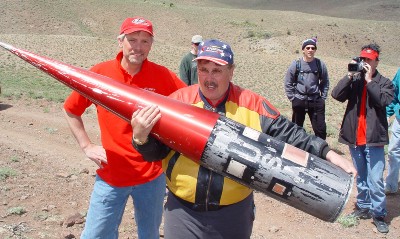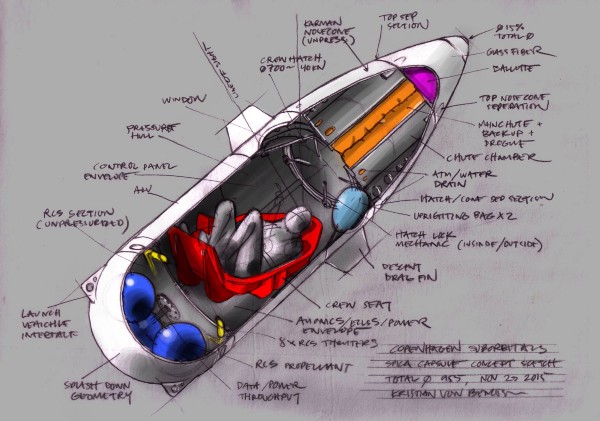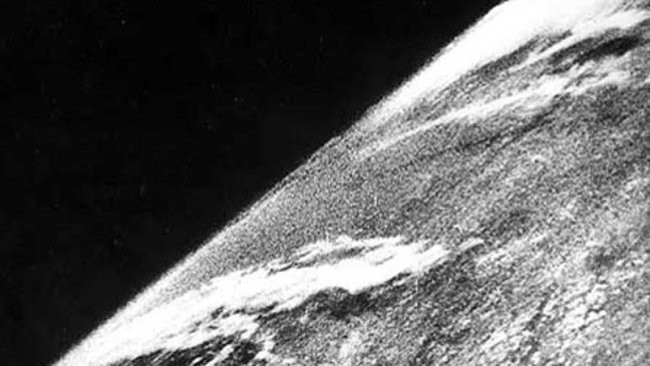

Which is more beautiful, or more inspiring: a private company bidding for a contract to send resupply rockets to the International Space Station, or a former Hollywood stuntman building a rocket from scratch and sending it into space for the hell of it?
I ask this because, lately, it feels like the way we talk about space has been changing. It’s less about exploration, and more about money. Space has become privatized. Proposals to land on and mine asteroids are justified less for being audacious, and more for being economical. While NASA’s budget for longer-term exploration is squeezed, the organization hands over its more regular work with satellites and space stations to for-profit companies, even when looking to design new ISS compartments. Just this month (August 2016), the FAA gave clearance for a private company to put a lander on the Moon for the first time. These are all technically impressive things, but they are not necessarily wondrous in the way things used to be wondrous.
My hunch is that the old spirit of exploration is still alive and well. It’s just not in the same places it used to be.
The amateur rocketry community is large, and global–one made up of people from all kinds of backgrounds, with all kinds of aims and ambitions. The most interesting types of people, though, are those who actually get their rockets into space.
Space is generally agreed to begin at the Kármán line, 62 miles [100 kilometers] above sea level; former stuntman Ky Michaelson and his Civilian Space Exploration Team (CSXT) built a rocket that reached 72 miles [116 kilometers] in 2004. These amateurs–made up of engineers, designers, and general-interest enthusiasts–were the first to put a homemade rocket into space. (They repeated the feat in 2014 with an identical rocket as a 10th anniversary celebration, the footage from which is embedded above.)
Michaelson calls himself “The Rocketman”–when I interviewed him he apologized repeatedly for not being able to talk about all of his “life story” (most of which he’s signed over for a documentary), but there was still plenty to go around. Growing up profoundly dyslexic, he dropped out of school in the ninth grade and remained illiterate until his mid-60s. Still, he’s had a successful career as an inventor: “I have a tremendous amount of drive,” he said. “When I was in school I was called a lot of things–”‘dumb,’ ‘stupid,’ “‘don’t want your kind around here’–it built a strong character for me.”
When he was 12, Michaelson started making gunpowder rockets for toy cars, racing them in alleys, before graduating to larger hydrogen peroxide rockets and eventually rocket-powered motorbikes. In 1969, he built the world’s fastest rocket-powered snowmobile, and he spent two decades after that attaching rockets to whatever he could: jetpacks, rollerskates, bicycles, portable toilets. All told, he claims to have held 72 different regional and international speed records at different points in his life.
His ingenuity and daredevil recklessness earned him a call from Dar Robinson, one of Hollywood’s most legendary stuntmen, and he spent much of the 1980s designing ways to pull off audacious car-chase sequences and plummets from tall buildings. But it was in the 1990s that he turned to the final challenge for a rocketeer: space.
“One day back in 1994 a guy walks into my office with a high-powered rocketry magazine, Tripoli,” he told me. “I see all these big rockets on the front page, and then I ran into an article for the altitude record, 31,000 feet. 31,000? I thought, “‘I can beat that, hell, it’s in my character!’ So I went and joined this rocketry organization, [and] I show up in the Black Rock Desert with this big aluminum rocket. It looks like a military sounding rocket, six inches in diameter, 18 feet long. The guy walks up and says, “‘How do you expect to get respect from your peers coming out with this thing?’ I say, “‘Because I have no peers.’

“So, I push the button and this thing just grenades, everybody’s flying under trucks and dodging parts as it blows up, and this guy comes over to me and says, “‘Oh, Ky, I’m so sorry.’ I say, “‘For what?’ He says, “‘Your rocket blew up!’ I say, “‘I work in the film business doing stunts and props, every time I push a button something blows up.’ I didn’t even think about it!”
CSXT was formed in 1995 as a collection of some 30 likeminded individuals, communicating online, swapping designs and ideas. Periodically they’d all travel out to the Black Rock Desert and try out their new models and see how high they could go–12.4 miles [20 kilometers] in 1996, 14.3 miles [23 kilometers] in 1997, 8.5 miles [13.7 kilometers] in 2000. Then came 2004, and the first amateur rocket to break the Kármán line–the GoFast rocket surpassed Mach 5.5 (4,163 miles per hour/6,700 kilometers per hour), reaching 72.1 miles [116 kilometers] before tumbling back down within a few miles of the launch site.

It’s interesting that CSXT mostly coordinated online; one of the most ambitious modern amateur rocketry groups, Denmark’s Copenhagen Suborbitals, is similarly as much a digital effort as a physical one. Founded in 2008 by artist and inventor Peter Madsen (also designer of the world’s largest amateur submarine, Nautilus) and space architect Kristian von Bengtson, CS’s plan is simple but audacious: It wants to be the first amateur group to send a manned rocket above the the Kármán line.
To that end, the group used to call itself an “open source” space program, although “we’ve renamed it now to be an “‘open project,'” says Mads Wilson, CS’s communications officer. It turns out, understandably, that there are certain international regulations when it comes to ballistic technology, although Wilson also pointed out that much of what they do is based on publicly available, declassified NASA documents from the 1950s and 1960s.

He explained: “Everyone could do what we are doing, because we’re not really inventing anything new. The technology that we are using, most of it is inspired by what NASA did–we use these old rockets and how they were built as inspiration. There’s a Bible in rocketry called Rocket Propulsion Elements, it’s freely available on the web, there’s nothing we do that you cannot find in this book. The theory is available for anyone, but there’s a huge difference between how you do something in theory and how you actually do it. Rocketry is so much more than the actual rocket.”
Michaelson would agree with him there. Both CS and CSXT have found that designing, building, and testing a rocket is the lesser problem when compared to the things that go with it. For CSXT, red tape was a nightmare; much of the story of the launches of 1995 to 2004, as Michaelson tells it, is one of dealing with petty bureaucracy.
“Now I’ve opened the doors for others to follow,” he said. “The FAA and the Office of Space Transportation [OST]–you can go online, they’ve got fairly simple forms to fill in. They’ve dropped all that red tape. We had mountains of red tape. It’s a federal offense to put a rocket into space in this country. There’s a quarter of a million dollar fine and five years in the slammer. Even after we did everything, the bonding, the insurance, all the environmental assessments, I call on Friday and say, “‘Where’s my license?’ [The OST official] says, “‘I don’t know.’ I say, “‘We’re leaving here Sunday, we’re flying Thursday, I got film crews coming out to document this stuff!’ He just says, “‘I don’t know.’
“When I left my door, I was going to push that button and do five years in the slammer. I had two kids here and a wife here, but I was going to do it. That Wednesday–and we had the rocket in the tower, ready to go–a guy came up and said, “‘Hey, your license is back in town.’ So it was right up to the last minute. And, unfortunately, that one blew up.”
For CS, which operates in Denmark, there are still challenges, but it’s found some clever ways to solve them–like launching its rockets from a platform (called, whimsically, “Sputnik”) floating in international waters. “Once we get to a point where we work above 100 kilometers then it gets a little bit more more difficult,” said Wilson. “There’s a lot of political things, but we don’t have to ask permission as such. We mostly just have to coordinate.”
On July 23, CS launched its latest rocket, the 18.4-foot [5.6-meter] Nexø I. It launched successfully from Sputnik, reaching .93 miles [1.5 kilometers] before falling back down. That was kind of a failure–CS’s flight engineers had hoped to reach higher than 3.7 miles [6 kilometers]–but, in the spirit of openness, there’s a thorough breakdown of the flight data on the organization’s blog.
Nexø I is the first CS rocket to have an active guidance system and liquid fuel, necessary steps before planning begins on the rocket that will take a human into space. That rocket (they’re planning to call it “Spica“) is coming at an indeterminate point in the future, and the astronaut onboard, strapped in, will essentially be payload. “You cannot control a rocket, you simply can’t,” said Wilson.
Once it reaches its apogee, it will fall, swiftly, to the Baltic Sea, where a boat or helicopter will–it is hoped–recover it before it has a chance to sink. The whole process, from launch to splash landing, will take about 15 minutes.

This is all the more impressive considering that CS started, essentially, “as an art project,” Wilson said. Both Madsen and von Bengtson left CS in 2014; Madsen was bored with the repetitive work involved–”he was always more of an artist than an engineer,” explained Wilson–while von Bengtson left to (briefly) work for Mars One, and on other projects like an unsuccessful Kickstarter to fund an amateur rocket launch to the Moon. The current core team consists of around 55 members, all volunteers, who work together in CS’s Copenhagen workshop. It has a paltry budget for a space program, less then $150,000 per year, donated by a group of several hundred supporters. If Spica is built, it will be, by some distance, the largest amateur rocket ever constructed, weighing nearly 8,820 pounds [four tonnes] and standing 42.7 feet [13 meters] tall. That’s only slightly smaller than a V2.
Still, I had to ask–why? Because, to me, it looks like old-fashioned romanticism.
“I think the romanticism is still there,” Wilson said. “I mean, we are all children of the 70s and 80s. We grew up with the legacy of Apollo, and we grew up watching the Space Shuttle on television. Space is “¦ it sounds a little corny, from Star Trek–space is the final frontier. We all dreamed about being astronauts–building big rockets is an acceptable compromise.
“From my point of view, over the years, many of the national-controlled space agencies like NASA and ESA, they have become, over time, paper tigers. For political reasons they can only take so much risk. But still, in the 60s or 70s you could not do this if you didn’t have government backup, because the technology you had to use was so insanely expensive. They invented the technology, and a lot of the technology that we use today is because of the work that they have done. We could not do what we do if they had not done it.”

I worried at this point that I was being unfair to modern space agencies. Yes, there possibly is a lack of naive idealism in mining an asteroid, but these are still organizations capable of magical things like landing a probe on a comet.
For a perspective that straddles the amateur and professional rocketry communities, I spoke to two leaders of Boston University’s Rocket Propulsion Group (BURPG)–its director Joe Beaupre and its vice director Jeremy Pedro. It’s been staffed by undergraduates since 2003, but kicked into higher gear in 2012 when “a guy who worked for SpaceX” came in and decided that they were going to be the first amateur group to design, build, and launch a rocket, Starscraper, with a payload of 99 pounds [45 kilograms] higher than 87 miles [140 kilometers]. They call it their “space shot.”
“We don’t want to just go to space, we want to go well into space and carry a payload,” explained Beaupre. “That’s the defined goal of the group. But, with the major space advancements, they have been done by governments or large corporations, and those corporations, those governments, have fed off of general interest of the public. So the reason we do it is to stimulate that interest by showing that on the amateur level you can do some pretty cool stuff, and then also you use that interest to create the talent pool in order to help drive on the industry. We want to make sure what’s done on the amateur level is keeping pace with what’s happening on the advanced, professional level.”
The “pretty cool stuff” that Beaupre mentions includes some frighteningly powerful rocket engines, developed entirely in-house by students with a range of academic backgrounds. They successfully raised more than $17,000 on Kickstarter to fund development of their hybrid Mark V engine in 2015; its successor, Lotus, which will actually go in the rocket (if all goes according to plan), is currently being developed and tested. The hope is that Starscraper will be reusable, reducing overall costs per mission launch and providing a legitimately competitive economic model for small-scale payload launches to suborbital space.

But, more than anything else, the thing that they’re proud of is getting students placements and jobs at space agencies, state-funded or private.
“We have this overarching space goal to guide our direction as far as our project, but we’re really here to develop students and enter aerospace industry–we want to develop those skills,” said Pedro. “Since the start of the space shot program in 2012 we’ve had a 100 percent success rate with our members either going into industry or going into the grad school of their choice. We use that as the example for how we’ve been successful training our members to be successful in industry.”
BURPG’s links with the space industry are useful–they very occasionally have mentors come in from the outside to help out, and they get “a lot of assistance” from the rest of the rocketry community, amateur and professional, when it comes to bureaucratic difficulties. They know that both of those worlds still have idealists playing a huge part.
“They’re companies, they need money to sustain themselves. To the side of that, though, a lot of their employees are in it for the passion of the industry, and the science behind it,” said Beaupre.
“I think that brings to light an interesting paradigm in that the actual exploration of space, the science, it’s kind of romantic. It’s pretty cool. But it’s unfortunately not at all self-sustaining. Unfortunately a lot of companies will only go as far as their business case will let them. This is where partnership between NASA and the industry is coming in, where NASA is providing guidance to companies on establishing a business case in low-Earth orbit [LEO], and the idea is that by helping them get into LEO and develop technologies there, they’re going to be able to tap off those resources and have the exploration on NASA’s side. So, it’s a little bit of a symbiotic relationship between the two.”
Pedro agrees–and emphasized that “the people who work for them are still very passionate about getting to space and really pushing the boundaries of what humans are capable of.”
Maybe the thing that illustrates this best is what happened to the Copenhagen Suborbitals crew at one of its last rocket launches. As Wilson told me, “It’s a little bit frightening sometimes, what we’re doing. I mean, we had 50,000 people watching our live stream when we launched the Nexø-I rocket, and you know, of course, there are not that many people interested in rocketry all over the world, so they also follow us and know what we’re doing.
“We got a call once when we were testing, from some guy from NASA: “‘Hi guys, good luck with the test, we’re a couple of hundred people sitting in an auditorium watching your live stream and we’re crossing our fingers.’ That was cool,” he said.

On October 24, 1946, scientists and engineers at the White Sands Missile Range in New Mexico launched a modified Nazi rocket, a V2, into space. It was the same type of rocket that had rained down on Allied cities in Europe during the last year of the war–as I write this, I can see from my window a London park that used to be a neighborhood.
The rocket had been converted from an engine of war into one of peace, and indeed beauty–its mission that day was to carry a 35mm camera into space for the first time. Clyde Holliday, an engineer, designed the camera to take a picture every one and a half seconds until the V2 came back down at 500 miles per hour [800 kilometers per hour] and smashed into the desert just as surely as it had left.
This grainy photo–taken from that roll–survived the fireball and is the first picture ever taken from space:

This was 11 years before Sputnik was launched from the Baikanour Cosmodrome in the Soviet Union. We commonly mark that moment as the official beginning of the Space Race–the point when two superpowers realized they were just as much rivals in science and engineering as they were in military projection and political ideology.
I’d like to argue that the picture taken from that V2 rocket in October 1946 is a better marker, though. It wasn’t the first time a rocket reached space–the Germans managed that during the war, and the Americans had done it a few times beforehand as well with the rockets they shipped back stateside in 1945. It was, though, the first time we humans had perspective enough to see near-everything of ourselves within a single frame–a direct precursor to the “Little Blue Dot” picture taken by Voyager 1 (and famously eulogized by Carl Sagan). As much as space exploration in the 20th century was so successful because of a desire for political oneupmanship, there is a powerful heritage of philosophical self-realization that came with it. Buzz Aldrin standing on the Moon and blocking out the Earth with the tip of his thumb is a more important justification for going to space than working out how to build better intercontinental ballistic missiles.
So maybe I’ve been approaching this whole things from the wrong angle. Maybe the real truth–the real poetry–in space exploration isn’t the rockets. It’s the comradeship that comes from watching a test engine fire up, and blossom into stars and flame, and knowing the feeling of what it means to go back to the drawing board. Or of finally getting your camera high enough to capture the curvature of the planet, with a high-definition version of that grainy black-and-white photo in 1946.
Michaelson, for his part, hasn’t gone near rocketry since the GoFast launch (with the exception of that 2014 anniversary relaunch). He’s focusing on a new challenge: He’s part of a team of engineers and designers working on a steam-powered rocket bike that will jump 1,640 feet [500 meters], at 396 miles per hour [637 kilometers per hour], across the Snake River in Idaho. Evil Knievel tried to do it in 1974, but failed.
He knows that other groups out there are pushing rocket technology further–now that getting into space has been done, the next big target is the first amateur payload delivered into orbit. There will, it seems, always be communities of people around the world trying to recreate, for themselves, what happened half a century ago. Who knows? Maybe we’ll all be able to watch a homebrew Rosetta landing on an asteroid sometime around 2060.
But Michaelson does have some advice for the other amateur rocketeers out there: “Just don’t quit. If it blows up, so what?”


How We Get To Next was a magazine that explored the future of science, technology, and culture from 2014 to 2019. This article is part of our Above & Beyond section, which looks at our understanding of the universe beyond Earth. Click the logo to read more.
